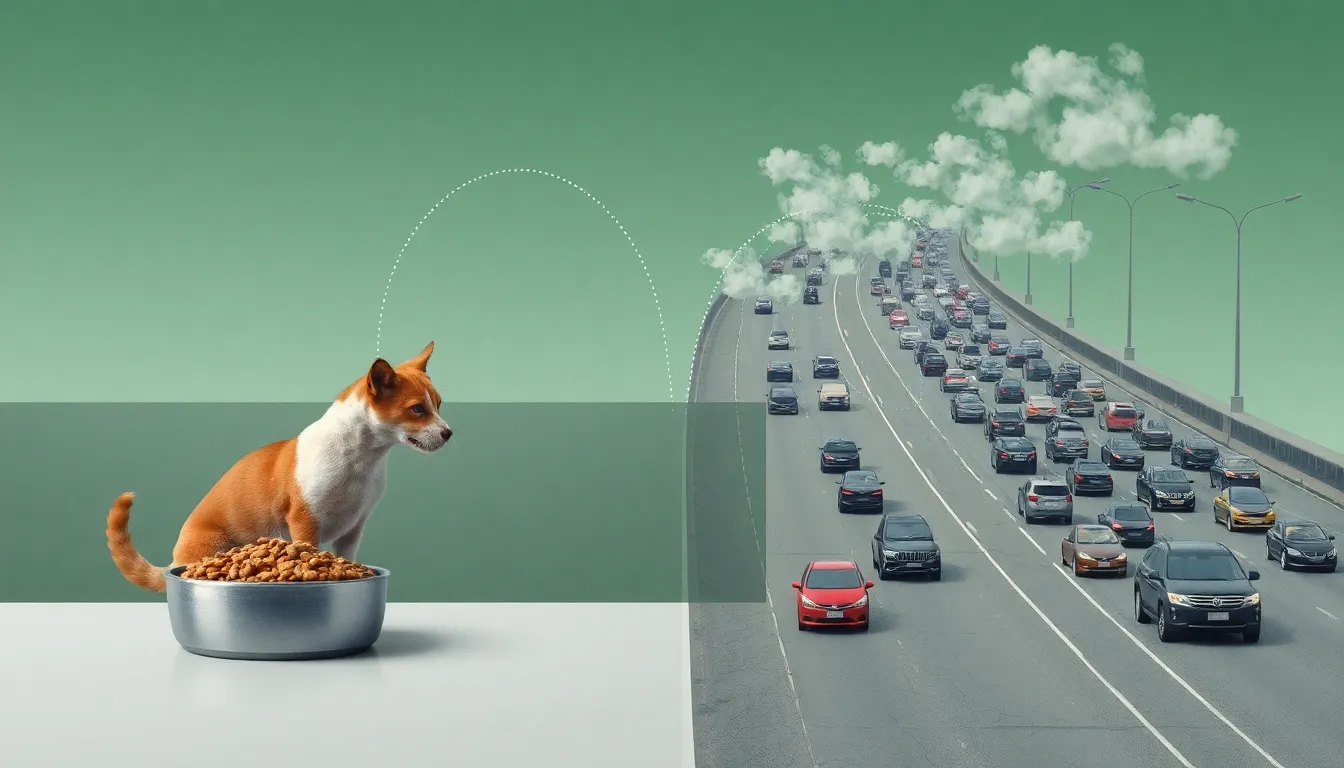Pets contribute to greenhouse gases like us. Here’s how to reduce their carbon pawprint, as the environmental footprint of our beloved companions is surprisingly substantial, with U.S. pet food emissions alone rivaling the pollution from millions of cars annually. Understanding these impacts and making informed choices is crucial for fostering a more sustainable relationship with our furry friends.
Key Implications:
- Dietary Choices: The type and quantity of pet food significantly influence environmental emissions, with “human-grade” and “fresh” options, as well as overfeeding, substantially increasing the carbon pawprint compared to traditional, balanced diets.
- Sustainable Consumption: Consciously choosing lower-impact protein sources like chicken or plant-based options, adhering to AAFCO-recommended protein levels, and supporting brands with environmental certifications directly contribute to measurable emission reductions.
- Holistic Pet Ownership: Minimizing a pet’s overall environmental impact extends beyond diet to include selecting smaller pets, adopting from shelters to avoid stimulating breeding demand, and opting for durable, regenerative, or recycled pet accessories.

U.S. Pet Food Emissions Rival 13.6 Million Cars Annually
The environmental footprint of U.S. pets is surprisingly substantial, particularly concerning their dietary choices. The consumption of meat by dogs and cats in the United States significantly contributes to greenhouse gas emissions. This impact is comparable to millions of vehicles on the road annually. A significant portion of this environmental burden stems from diet choices and the growing trend towards “human-grade” pet foods.
Remarkably, U.S. dogs and cats are responsible for more than 25% of the total environmental impact from U.S. meat consumption. This statistic alone underscores the immense scale of the issue. The pollution generated from the meat consumed by U.S. dogs and cats is equivalent to the pollution created from driving 13.6 million cars for one year (UCLA Study). This highlights how Pets contribute to greenhouse gases like us. Here’s how to reduce their carbon pawprint through informed choices.
The Rising Impact of “Human-Grade” and “Fresh” Pet Foods
Traditional pet food often repurposes animal by-products, effectively utilizing parts otherwise considered waste. This approach contributes to a more sustainable system within the food industry. However, the recent trend of using “human-grade” meat in pet food dramatically increases its climate impact. This approach utilizes animal parts that would not have gone unused in the human food chain. Unlike traditional pet food, these “human-grade” options frequently compete directly with human consumption for resources, directly exacerbating the environmental toll.
The growing demand for “fresh,” refrigerated pet food also plays a significant role in this increased environmental burden. These products typically require more energy for production, specialized packaging, and temperature-controlled transportation. This contrasts sharply with traditional kibble and wet food in terms of resource intensity. The perceived benefits of such foods often outweigh the actual scientific evidence supporting them.
Evaluating Health Claims: Traditional vs. “Human-Grade” Diets
Despite the premium pricing and extensive marketing, there is a distinct lack of robust scientific evidence suggesting superior health benefits from refrigerated, fresh, or “human-grade” pet food. Traditional kibble and wet food, when formulated by reputable brands, provide complete and balanced nutrition for pets. Many veterinarians confirm that these conventional options meet all dietary requirements for optimal pet health, offering a balanced diet.
Prioritizing diets based on unproven claims can unknowingly increase your pet’s carbon pawprint. It also might not offer any real health advantages over traditional, well-researched options. To truly reduce their carbon pawprint, considering sustainable pet food choices and focusing on proven nutritional science is key. For those seeking alternatives, exploring options like best organic dog food picks can be a starting point, but always verify their environmental impact and nutritional completeness.

Optimizing Pet Diets for Measurable Emission Reductions
Pets contribute to greenhouse gases like us. Here’s how to reduce their carbon pawprint through specific and quantifiable adjustments to their diets. Adherence to recommended protein levels and selection of lower-impact protein sources can directly reduce a pet’s environmental footprint. These dietary choices offer a practical path for owners to make a tangible difference.
Tailoring Protein Intake for Sustainability and Health
Optimal protein percentages are crucial for both pet health and environmental impact. According to the Association of American Feed Control Officials (AAFCO), protein should constitute approximately 18% of an adult dog’s diet. For adult cats, this figure is higher, with protein constituting approximately 26% of their diet (AAFCO). Meeting these specific dietary recommendations is fundamental.
A comparative analysis of protein sources reveals significant environmental differences. Beef is identified as the most pollutive protein, due to factors like methane emissions and land use. In contrast, chicken and fish are considered lower-impact options. The most environmentally friendly choices are plant-based options, which pollute the least. Guiding pet owners towards lower-impact protein choices can measurably reduce their pet’s carbon pawprint.
The Impact of Overfeeding and Sustainable Brand Choices
Beyond protein sources, managing meal portions is critical. Overfeeding contributes to environmental impacts by increasing demand for pet food production. It also leads to poorer pet health, with diet making up the majority of a dog’s weight problem. Avoiding overfeeding offers quantifiable benefits for both reducing environmental impact and improving pet health. This simple adjustment can lead to significant reductions in a pet’s overall footprint.
To make even more sustainable choices, pet owners can identify brands focused on environmental responsibility. Checking labels for ingredients like organ meats or crickets indicates a brand’s effort to use novel, lower-impact protein sources. Additionally, look for certifications such as climate neutral, regenerative organic, or B Corp. These certifications provide independent verification of a brand’s sustainability claims, helping pet owners make informed choices that benefit both their companions and the planet. For more insights on ethical pet food options, you might explore resources like this guide on the best organic dog food.

Holistic Strategies for a Smaller Pet Pawprint
Beyond dietary considerations, a pet’s carbon pawprint extends to their size, origin, and the products they use. Choosing smaller pets, adopting from shelters, and selecting durable or recycled accessories offer significant and quantifiable ways to reduce a pet’s overall environmental impact. This holistic approach helps pet owners reduce the impact their pets contribute to greenhouse gases like us.
Consider Pet Size for a Lighter Pawprint
The size and breed of a pet directly influence their environmental footprint. Smaller pets generally consume fewer resources throughout their lives. Smaller dogs, for example, eat less food, which reduces demand on agricultural resources and associated emissions. This directly translates to a smaller climate impact compared to larger breeds that require substantially more calories.
Furthermore, smaller pets create less waste over their lifespan. They also require less material for accessories like beds, crates, and toys. This reduction in consumption and waste generation significantly lowers their overall environmental impact. Opting for a smaller companion is a practical way to minimize your pet’s ecological footprint from the outset.
Adopt, Don’t Shop: Reducing the Carbon Pawprint
Adopting a pet from a shelter is a profoundly responsible environmental decision. These animals already exist, and their initial carbon impact is effectively “priced-in.” By choosing adoption, you avoid stimulating the demand creation that fuels commercial breeding operations. Breeding new animals requires resources for gestation, early-life care, and transport, all of which add to an animal’s carbon burden.
Supporting shelters helps reduce the number of homeless animals, thereby decreasing the collective environmental strain associated with pet overpopulation. It’s a choice that directly impacts the existing pet population without generating new demand. This approach helps in reducing how much pets contribute to greenhouse gases like us, making a tangible difference.
Sustainable Choices for Pet Accessories
The materials chosen for pet accessories also play a crucial role in environmental sustainability. Accessories made from regenerative, durable, or recyclable materials significantly reduce environmental impact. Regenerative materials, for instance, are sourced from systems that improve soil health and sequester carbon, rather than depleting resources.
Durable products withstand wear and tear, requiring less frequent replacement. This reduces manufacturing demand and minimizes waste sent to landfills. Opting for items made from recycled content further closes the loop on resource consumption. When considering pet essentials, making informed choices about materials is key to fostering a smaller overall pawprint.
Featured image generated using Flux AI
Middletown Press: “Pets contribute to greenhouse gases like us. Here’s how to reduce their carbon pawprint”
UCLA study: “The truth about cats and dogs environmental impact”
